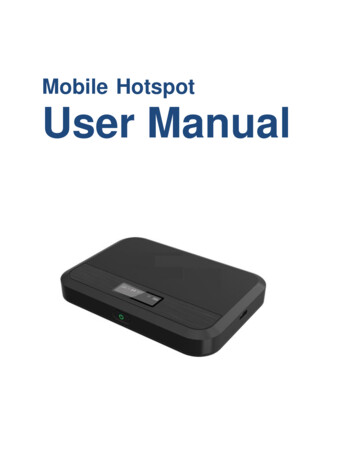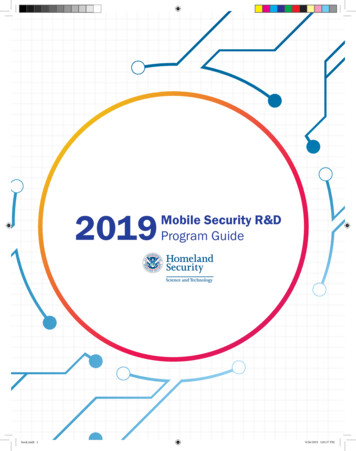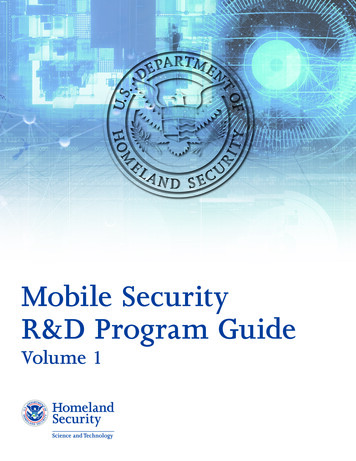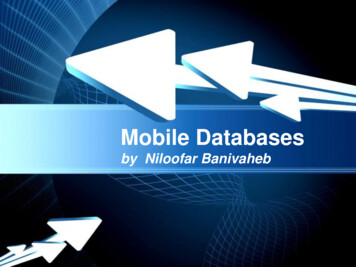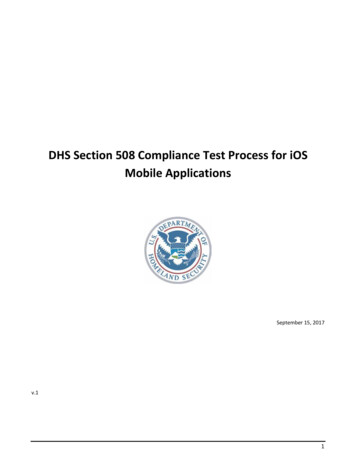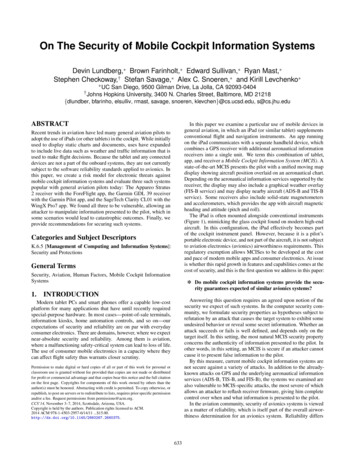
Transcription
On The Security of Mobile Cockpit Information SystemsDevin Lundberg, Brown Farinholt, Edward Sullivan, Ryan Mast, Stephen Checkoway,† Stefan Savage, Alex C. Snoeren, and Kirill Levchenko UC San Diego, 9500 Gilman Drive, La Jolla, CA 92093-0404† Johns Hopkins University, 3400 N. Charles Street, Baltimore, MD 21218{dlundber, bfarinho, elsulliv, rmast, savage, snoeren, klevchen}@cs.ucsd.edu, s@cs.jhu.eduABSTRACTIn this paper we examine a particular use of mobile devices ingeneral aviation, in which an iPad (or similar tablet) supplementsconventional flight and navigation instruments. An app runningon the iPad communicates with a separate handheld device, whichcombines a GPS receiver with additional aeronautical informationreceivers into a single unit. We term this combination of tablet,app, and receiver a Mobile Cockpit Information System (MCIS). Astate-of-the-art MCIS presents the pilot with a unified moving mapdisplay showing aircraft position overlaid on an aeronautical chart.Depending on the aeronautical information services supported by thereceiver, the display may also include a graphical weather overlay(FIS-B service) and may display nearby aircraft (ADS-B and TIS-Bservice). Some receivers also include solid-state magnetometersand accelerometers, which provides the app with aircraft magneticheading and attitude (pitch and roll).The iPad is often mounted alongside conventional instruments(Figure 1), mimicking the glass cockpit found on modern high-endaircraft. In this configuration, the iPad effectively becomes partof the cockpit instrument panel. However, because it is a pilot’sportable electronic device, and not part of the aircraft, it is not subjectto aviation electronics (avionics) airworthiness requirements. Thisregulatory exemption allows MCISes to be developed at the costand pace of modern mobile apps and consumer electronics. At issueis whether this rapid growth in features and capabilities comes at thecost of security, and this is the first question we address in this paper:Recent trends in aviation have led many general aviation pilots toadopt the use of iPads (or other tablets) in the cockpit. While initiallyused to display static charts and documents, uses have expandedto include live data such as weather and traffic information that isused to make flight decisions. Because the tablet and any connecteddevices are not a part of the onboard systems, they are not currentlysubject to the software reliability standards applied to avionics. Inthis paper, we create a risk model for electronic threats againstmobile cockpit information systems and evaluate three such systemspopular with general aviation pilots today: The Appareo Stratus2 receiver with the ForeFlight app, the Garmin GDL 39 receiverwith the Garmin Pilot app, and the SageTech Clarity CL01 with theWingX Pro7 app. We found all three to be vulnerable, allowing anattacker to manipulate information presented to the pilot, which insome scenarios would lead to catastrophic outcomes. Finally, weprovide recommendations for securing such systems.Categories and Subject DescriptorsK.6.5 [Management of Computing and Information Systems]:Security and ProtectionsGeneral TermsSecurity, Aviation, Human Factors, Mobile Cockpit InformationSystems1.] Do mobile cockpit information systems provide the security guarantees expected of similar avionics systems?INTRODUCTIONAnswering this question requires an agreed upon notion of thesecurity we expect of such systems. In the computer security community, we formulate security properties as hypotheses subject torefutation by an attack that causes the target system to exhibit someundesired behavior or reveal some secret information. Whether anattack succeeds or fails is well defined, and depends only on thetarget itself. In this setting, the most natural MCIS security propertyconcerns the authenticity of information presented to the pilot. Inother words, in this setting, an MCIS is secure if an attacker cannotcause it to present false information to the pilot.By this measure, current mobile cockpit information systems arenot secure against a variety of attacks. In addition to the alreadyknown attacks on GPS and the underlying aeronautical informationservices (ADS-B, TIS-B, and FIS-B), the systems we examined arealso vulnerable to MCIS-specific attacks, the most severe of whichallows an attacker to reflash receiver firmware, giving him completecontrol over when and what information is presented to the pilot.In the aviation community, security of avionics systems is viewedas a matter of reliability, which is itself part of the overall airworthiness determination for an avionics system. Reliability differsModern tablet PCs and smart phones offer a capable low-costplatform for many applications that have until recently requiredspecial-purpose hardware. In most cases—point-of-sale terminals,information kiosks, home automation controls, and so on—ourexpectations of security and reliability are on par with everydayconsumer electronics. There are domains, however, where we expectnear-absolute security and reliability. Among them is aviation,where a malfunctioning safety-critical system can lead to loss of life.The use of consumer mobile electronics in a capacity where theycan affect flight safety thus warrants closer scrutiny.Permission to make digital or hard copies of all or part of this work for personal orclassroom use is granted without fee provided that copies are not made or distributedfor profit or commercial advantage and that copies bear this notice and the full citationon the first page. Copyrights for components of this work owned by others than theauthor(s) must be honored. Abstracting with credit is permitted. To copy otherwise, orrepublish, to post on servers or to redistribute to lists, requires prior specific permissionand/or a fee. Request permissions from permissions@acm.org.CCS’14, November 3–7, 2014, Scottsdale, Arizona, USA.Copyright is held by the authors. Publication rights licensed to ACM.2014 ACM 978-1-4503-2957-6/14/11 . 3
determine the true state of affairs. This point is worth emphasizing:modern aviation safety depends on pilots successfully reconcilingpossibly conflicting information presented by multiple sources. Inthis regime, the FAA considers current aeronautical informationservices (ADS-B, TIS-B, and FIS-B) supplementary in nature.For example, AC 20–172A states, “The installation of ADS-B inavionics provides the pilot(s) with supplemental information.” Inthis view, there is no harm in additional information, because pilotscan optimally reconcile all information presented to them. By necessity, this must hold even when some sources are manipulated by anattacker. We believe this view is too optimistic: it is unreasonable toexpect pilots to always correctly reconcile conflicting informationpresented by multiple systems. It becomes necessary, therefore, toconsider pilot decision-making in order to assign potential outcomesto attacks on information systems.We propose one way of modeling this decision-making processwhen an information system is under attacker control. We believeour approach may be useful in the analysis of similar systems. Itis not a replacement, however, for empirical evaluation. Thus, ouranswer to the above question is only partial; however, we believethat it is a fruitful first step.In Section 6 we evaluate several MCISes on the market today. Ouranalysis finds that under several scenarios an attacker with modestcapabilities can exploit the weak security of these systems to causecatastrophic outcomes. The situation need not be hopeless, however.The third question we investigate is:Figure 1: A modern cockpit mobile arrangement consisting ofa mobile computing device (e.g. iPad) and a GPS and UAT receiver.from security in its adversary: the adversary of reliability is Nature,while the adversary of security is a motivated attacker. In reliabilityanalysis, Nature is a stochastic process that can be tamed by drivingthe probability of a system failure to an acceptable level. However,unless a system is absolutely reliable, a determined attacker canexploit the tiniest sliver of vulnerability. These were lessons learnedtwo decades ago by the computer security community. The inheritedwisdom of that experience is that security requires separate explicitconsideration.Reliability as considered in airworthiness determination differsfrom computer security in another important way. The airworthinessof a system is considered in terms of its effect on overall flightoutcome should the system fail. By way of example, FAA AdvisoryCircular (AC) No. 20–149A, which describes one means of gaining airworthiness approval for FIS-B avionics installed on aircraft,mandates that, “the effect of undetected errors in FIS-B products. is no greater than a minor failure condition.” A “minor failurecondition” is one which does not significantly reduce aircraft safetyand which involves crew actions well within their capabilities [16,Ch. 3]. Thus, airworthiness depends not only on the componentitself, but also on the severity of the overall outcome taking intoaccount crew actions.For computer security analysis to be practically useful in determining airworthiness, we must reason about possible crew actionsin response to (detected or undetected) attacks. In other words, toconnect security results to airworthiness, we must connect MCISoutput to pilot actions to overall flight safety. This is the secondquestion we consider:] Can consumer mobile cockpit information systems be redesigned to satisfy the airworthiness requirements of comparable avionics systems?Our answer is a guarded yes, although concerns about the integrityof GPS and aeronautical information service signals themselvesstill remain. We make several recommendations for securing suchsystems, and we believe the proposals do not impose an undueburden on developers.In summary, our contributions are:vvv] How does the security of mobile cockpit information systems affect flight safety?There are two ways to go about answering this question. The firstis empirical, using experiments with pilots in a controlled setting.While this approach is the most reliable, it is cost-prohibitive andunlikely to be adopted by manufacturers or regulators.The second approach is to work with a model of pilot decisionmaking. The simplest such model assumes, pessimistically, thata pilot will accept as correct all information presented to her by acompromised MCIS and act accordingly. Unfortunately, this lineof reasoning leads one to conclude, for example, that nearly allnavigation systems (GPS, VOR/DME, ILS) should not be usedbecause they all are easily spoofed. The way out of this conundrumis to insist that the pilot rely on multiple sources of information to2.We define the security threats facing Mobile CockpitInformation Systems (MCISes) and develop a modelfor evaluating information systems where assessing theseverity of potential attacks requires modeling a humanoperator.We analyze three existing MCISes. We find that allthree allow an attacker to provide false information tothe pilot; two of these systems allow an attacker to carryout a delayed or situation-triggered attack by replacingreceiver firmware; all three are vulnerable to a maliciousapp installed on the tablet device.We provide recommendations for securing MCISes thatwould protect against the MCIS-specific vulnerabilitieswe identified. We believe our recommendations do notimpose an undue burden on developers.BACKGROUNDThis work is about mobile cockpit information systems (MCISes)used by pilots as an aid to situation awareness during flight. MCISesare targeted at pilots in small general aviation aircraft that lackthe sophisticated cockpit information systems found on larger andnewer aircraft. Physically, an MCIS consists of two devices: anaeronautical information service receiver and a general-purposetablet PC—most commonly an iPad. The receiver relays broadcastsfrom multiple aeronautical information services to the app, whichpresents the information to the pilot. Figure 3 illustrates thesecomponents, which we describe next.634
Figure 2: The Stratus 2 receiver (left), ForeFlight iOS App (center), and Garmin Pilot iOS app (right). The app is showing real-timeweather against a US sectional aeronautical chart. The aircraft’s position is shown as a blue plane along the magenta planned route.App screenshots Copyright 2012 Sporty’s Pilot Shop, used with permission.2.1Aeronautical Information Servicestion to ADS-B by allowing aircraft equipped with ADS-B to knowabout aircraft using a transponder only.There are two data links used to disseminate ADS-B and TIS-B:Mode S Extended Squitter on 1090 MHz (1090ES) and UniversalAccess Transceiver protocol on 978 MHz (UAT). Both data linkshave a data rate of 1 Mbit/sec; however, 1090ES uses 112-bit packetswhile the UAT data link supports larger packet sizes, making it moresuitable for larger messages. UAT is only used in the United States.Mobile cockpit information systems are built around three aeronautical information services.2.1.1GPSMost readers are already familiar with the Global PositioningSystem (GPS), a satellite-based positioning system. GPS receiversare entirely passive, allowing the 32-satellite constellation to supportan arbitrary number of users. GPS receivers provide horizontal accuracy down to one meter [25], making GPS an attractive alternative tothe system of ground-based navigation aids still in wide use today.Known vulnerabilities. ADS-B and TIS-B services are providedover the 1090ES and UAT data links, neither of which is authenticated. Attacks on these services have been considered in theresearch community [7, 50, 54, 56]; Strohmeier et al. [54] providean overview of this problem and propose a number of solutions.Like GPS attacks, these require a transmitter and may be detectedby other receivers near the victim.Known vulnerabilities. The non-interactive (passive) nature ofGPS makes it vulnerable to replay attacks. Moreover, the nonmilitary navigation signal is unauthenticated, making spoofing possible. These shortcomings of GPS are well known, with resultson GPS spoofing [27, 28, 38, 46, 51, 57, 59], software attacks onGPS [41], GPS cryptography [60], and more [3, 9, 11, 29, 31, 43,47, 48, 52, 55, 61]. In this work, we do not address these attacksand proposed fixes. We note, however, that attacks on GPS requirethe attacker to transmit a GPS signal. Ground-based attacks againstan airborne target would be detectable by nearby receivers.2.1.22.1.3FIS-BFlight Information Service–Broadcast (FIS-B) provides severalkinds of real-time information, most notably graphical weather data.Like TIS-B, FIS-B is a free broadcast service provided by the FAA.Figure 2 (center and right) shows TIS-B weather data overlaid onan aeronautical chart. FIS-B also provides textual weather andtime-sensitive pilot advisories.ADS-B and TIS-BKnown vulnerabilities. Like ADS-B and TIS-B, FIS-B is transmitted over the unauthenticated UAT data link; it is, therefore, alsovulnerable to spoofing.Automatic Dependent Surveillance–Broadcast (ADS-B) is an aircraft position self-reporting system. An aircraft equipped with anADS-B transmitter broadcasts its own position (obtained from asource such as GPS); aircraft equipped with an ADS-B receivercan display other aircraft to the pilot and issue collision avoidancewarnings if necessary. The United States Federal Aviation Administration (FAA) has mandated that by 2020, all aircraft operatingin airspace that today requires a transponder will be required tobroadcast their position via ADS-B. The receivers considered in thiswork do not transmit ADS-B data; they only receive ADS-B fromaircraft equipped to do so.Traffic Information Service–Broadcast (TIS-B) is an aircraft position reporting system. TIS-B uses the same data format as ADS-B;however, TIS-B position information is broadcast by FAA groundstations in the United States and includes aircraft positions fromradar-based aircraft tracking systems. As such, it provides a transi-2.2Aeronautical Information ReceiversAvailability of the services described above has created a marketfor devices capable of receiving and displaying this information.While it is possible to equip an aircraft with avionics capable ofreceiving and presenting this information on a cockpit display, anMCIS is a far cheaper alternative for doing so.The portable aeronautical information receivers that are the subject of this work combine a GPS receiver and UAT receiver into acompact, battery-operated device. Many also incorporate a 1090ESreceiver—all three receivers we examined do.Some receivers also include an Attitude and Heading ReferenceSystem (AHRS) module, which provides aircraft attitude (pitch and635
roll) as well as magnetic heading using solid-state accelerometersand magnetometers. AHRS information is displayed in the style of amodern Primary Flight Display (PFD) and is marketed as a backupto primary flight instruments. The Stratus 2 unit shown in Figure 2(left) is a battery-powered receiver incorporating a GPS, UAT, and1090ES receiver and an AHRS module.Nearly all receivers communicate with the tablet using eitherWiFi or Bluetooth. A wireless link reduces clutter and allows thereceiver to be placed more conveniently inside the cockpit.2.3Aeronautical Information AppsThe receiver provides all information to an aeronautical information app running on the tablet. Modern aeronautical informationapps evolved from Electronic Flight Bags (EFBs), electronic replacements for paper documents carried by pilots. An EFB includesaeronautical charts, approach plates, aircraft manuals, and checklists. EFBs replace several pounds of paper and provide an efficientinterface to these documents. The simplest EFBs are nothing morethan PDF viewers, while more sophisticated EFBs provide featuressuch as interactive checklists.Because they were already familiar to pilots, EFBs provided anatural place to add real-time data from aeronautical informationservices. The emergence of low-cost GPS receivers and the introduction of services such as ADS-B and FIS-B brought more kindsof information to what are now known by the general term aviationapps. Such applications promise to improve general aviation safetyby providing pilots with more information to aid in-flight decisionmaking. There is a real danger, however, that pilots will come to relyon these apps while neglecting more basic skills. Such apps mayalso engender a false sense of security, leading pilots to cut cornersin pre-flight preparation or to be less vigilant in flight [4, 15].The problem of over-reliance on automation has garnered considerable attention in the aviation safety community. In this work,we take pilot reliance on an MCIS, to a greater or lesser degree, asgiven. From a computer security point of view, we would prefer tomake these systems more secure rather than rely solely on a pilot’sability to make critical decisions under pressure.2.4Figure 3: Components of a mobile cockpit information system.3.4.SECURITY MODELIn this section, we describe the MCIS threat model. Our motivation is an attacker intent on disrupting the flight of a particularaircraft. An attacker can attack a target directly by manipulatinginformation presented by the MCIS to the pilot of the target aircraft.This is the mode of attack implicit in most of the scenarios we describe in Section 5. An attacker can also attack the target indirectlyby manipulating information presented to pilots of nearby aircraft.In this regime, the aircraft with the compromised MCIS becomes aguided weapon used to attack another aircraft.We begin our security analysis with a description of the attacksurfaces of an MCIS.Mobile Computing EnvironmentAeronautical information apps run on ordinary consumer tabletPCs. By far the most popular choice is an iPad, although severalaviation apps are available for Android also. Of the apps we examined, only Garmin Pilot has an Android version with the samefunctionality as the iOS version.2.5RELATED WORKTo our knowledge, we are the first to consider the security of mobile cockpit information systems. With the rise of mobile computingdevices, there has been considerable work on mobile security [2, 42],most of which has focused on security issues internal to the platform.In our security analysis, we lean on the numerous studies of mobilemalware [22, 58, 65, 66] to motivate our malicious app attackermodel (Section 4.2). The technique of using the mobile device itselfto attack a peripheral was used by Frisby et al. [24] to attack mobilepoint-of-sale terminals.Firmware update attacks have been used on printers [8], medicaldevices [26], batteries [35], voting machines [1], among others.Attacks on Bluetooth and WiFi are too numerous to mention.Integrity attacks on GPS and ADS-B have already been discussedin Section 2.1.Government Regulations4.1In the United States, use of mobile computing devices in thecockpit is regulated by the FAA. The FAA has been open to theuse of EFBs and has issued detailed guidance on their use [17–19]. Broadly speaking, portable EFBs, that is, EFB systems notintegrated into the aircraft, do not require software certification.(Airborne software systems are normally certified to the RTCA DO178B standard.) However, air carrier use of such EFBs requires FAAapproval—use in general aviation does not.Furthermore, EFBs used by air carriers are prohibited from showing “own-ship position.” That is, they may not display the locationof the aircraft on an aeronautical chart or procedure plate. Generalaviation use carries no such restriction, and indeed, all of the appswe examine provide “own-ship position.” See Figure 2 (center andright). Regarding such use, the FAA only warns, “The EFB systemdoes not replace any system or equipment (e.g. navigation, communication, or surveillance system) that is required by 14 CFR part91” [17].Attack TargetsAn MCIS is made up of several discrete components linked bycommunication channels, illustrated in Figure 3. The receiver, app,tablet, and aeronautical information services have already been described in Section 2. The remaining service, the App Data Provider,is a subscription service providing up-to-date information not disseminated via the aforementioned aeronautical information services.(In all cases we examined, the App Data Provider is the same asthe app developer.) This additional information, which includes theaeronautical charts and procedure plates displayed to the pilot, isupdated on the ground, over a normal Internet connection.An attack on an MCIS entails attacking one or more of the components or channels shown in Figure 3. We describe possible attacksagainst each channel or against the receiver or app directly, what anattacker might gain from each, and the steps necessary to protectit. We do not discuss attacks on the information services (GPS,ADS-B, TIS-B, FIS-B) themselves, which have been considered in636
prior work (see Section 2.1). Instead, we focus on attacks unique tothe MCIS platform.Table 1 lists the information provided by an MCIS, along withthe conventional source of each piece of information. A successfulattack would allow an attacker to control or deny access to one ormore of these variables. Our next task is to define how a successfulattack on a component or channel would affect these variables. InSection 5 we consider scenarios in which an attacker controls one ormore of these variables, and the potential outcome of such attacks.We consider only attacks on the integrity and availability of acomponent or communication channel. Attacks on secrecy/privacyare less of a concern, because most of the information involved isnot confidential in nature. We also note that we do not considerissues of receiver or app reliability, a distinct but separate concernin an environment like an aircraft cockpit.to the pilot. This is the most serious attack on an MCIS. Fortunately,recent progress in mobile platform security, most notably codesigning, has made such attacks difficult. Nevertheless, securityproblems still remain. Compounding the problem is that in manycases, the tablet PC may be used for non-aviation purposes, exposingit to additional malware risks.4.2Attacker ModelAn attacker’s ability to carry out attacks on parts of the MCISdescribed above depend on the attacker’s technical capabilities. Weconsider five classes of attacker defined by the level of access to theMCIS under attack. We assume that an attacker has the technicalskills and equipment of a properly motivated graduate student, andis only limited by his access to the target MCIS. These five types ofaccess are:Receiver to App channel. In all three of the MCISes we examined,the receiver communicates with the app on the mobile computerwirelessly, using either Bluetooth or WiFi. With the exception ofEFB data, which is preloaded before flight, all information presentedto the pilot must be sent over this channel. The channel may also beused to control some functions of the receiver and to send firmwareupdates to the device.The simplest class of attacks involves denying access to the channel (e.g., by jamming). This would deny the pilot access to everything except EFB data. However, such an attack is easily detected,although it may be misattributed to receiver failure. A more subtle attack would be to selectively deny access to specific information; thisattack would require the channel to be unencrypted or vulnerable topacket timing/size attacks. In the absence of proper authentication,an attacker could tamper with all information sent over this channel.Finally, in the absence of replay protection, the channel would bevulnerable to selective replay of old information.Brief proximity. Brief proximity is the weakest class, granting anattacker brief physical proximity to the receiver for a few minuteswhile the receiver is powered. This allows the attacker access tothe wireless communication channels, which he may use to gainlasting control over the MCIS. Such access might be arranged whilethe pilot is preparing for flight on the ground. A properly securedreceiver to app communication channel and properly implementedaeronautical information service receiver components can protectagainst such an attack.Brief access. Brief access grants an attacker physical access to thereceiver for a few minutes. Brief access implies brief proximity.Physical access is a fairly powerful capability that includes theability to replace the device with an attacker-controlled facsimile orrender the MCIS inoperable. To defend against such an attack, theapp must be able to detect receiver tampering. (See discussion ofreceiver integrity in Section 4.1.) The pilot should also have a wayof detecting tablet PC tampering or replacement.App to Internet channel. This channel is used to retrieve EFBinformation as well as app updates and receiver firmware updates.By denying access to this channel, an attacker would be able toprevent EFB updates and potential security-related firmware updates.If a failure to update EFB data is not properly indicated, the pilotmay be unaware she is lacking important flight information.1 Inthe absence of proper authentication, an attacker could tamper withEFB data.Time-of-use proximity. Time-of-use proximity grants an attackerphysical proximity to the MCIS while it is in use. Practically, thisrequires either a tracking directional antenna or the ability to plant adevice on the aircraft. Time-of-use proximity implies brief proximity. At a minimum, an attacker with time-of-use proximity can jamall communication links, denying access to all real-time information.Receiver. The receiver provides the app with non-EFB informationshown in Table 1. Attacks on receiver availability are similar toattacks on the receiver to app channel availability; however, in somecases, they may be easier to carry out (e.g., via battery drain attacks).A successful attack on receiver integrity is much more serious. Anattacker would be able to impersonate the receiver, and thus providearbitrary non-EFB data to the app. Reflashing device firmware isthe most common means of compromising device integrity, andthis is the most serious attack we consider in Section 6. However,reflashing alone does not automatically imply integrity compromise,if the app validates the authenticity of the data from the receiver.Unless the attacker can also learn the keying material used by thelegitimate firmware to sign updates, reflashing alone will only resultin a denial of device availability.Update man-in-the-middle. An attacker with update man-in-themiddle capability has control over the Internet connection betweenthe tablet and the app data provider. Such access might be arrangedby enticing the user to use an attacker-controlled WiFi access point.At a minimum, a man-in-the-middle attacker can deny the app accessto the app data provider. A properly secured channel between appand app data provider would prevent tampering with EFB data andany receiver firmware updates sent to the app.Collocated app. The collocated app capability allows an attackerto install an app on the tablet device. We assume the attacker canarrange for the app to be executing when the device is in use. (SeeSection 6.5 for a description of the demonstration attack app wedeveloped.) An attacker might gain such a capability through socialengineering, by exploiting a vulnerability in the tablet operatingsystem, or by gaining control of an already installed app.In the ideal case, any combination of the above capabilities wouldallow an attacker no more than the ability to deny use of the MCIS.If the necessary security measures are absent or are not implementedproperly, an attacker could gain the ability to tamper with MCISdata presented to the pilot.App and tablet PC. The tablet is the sole MCIS interface to theuser. A successful
some scenarios would lead to catastrophic outcomes. Finally, we provide recommendations for securing such systems. Categories and Subject Descriptors K.6.5 [Management of Computing and Information Systems]: Security and Protections General Terms Security, Aviation, Human Factors, Mobile Cockpit Information Systems 1. INTRODUCTION




